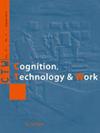基于错误的职业安全健康教育增强现实学习系统。
IF 3.4
3区 工程技术
Q2 ENGINEERING, INDUSTRIAL
引用次数: 0
摘要
错误可能会产生危险的后果,因此在大多数以公司为基础的职业技术教育和培训(TVET)中都有一种预防策略。相反,由于心理模型与现实不匹配,错误提供了一个有用的学习机会,特别是改善职业安全与健康(OSH)。目的提出一种基于从错误中学习的学习系统的教学概念。学习者应该通过在增强现实中呈现错误后果来直接体验错误行为的后果,以避免负面的、危险的或成本密集型的结果。方法经验数据证明,错误在技职教育中特别有效。系统地采用工作系统的正式描述来概述工作、有关职业安全与卫生的错误和教学概念之间的联系。概念验证系统地执行开发的学习系统的用例。它支持从技术、安全和教学角度、命名含义和限制进行批判性反思。结果:通过从错误中学习,以工作为基础的教学理念支持职业安全与健康能力。后者集成了工作系统的数字孪生,在技术概念验证中模拟和可视化已识别错误行为的危险错误后果。结果证明了在工作过程中检测动作错误和在增强现实中模拟错误后果的能力。结论职业安全卫生教育技术学习系统通过虚拟结果的展示扩展了现有的学习方法。然而,对于具有预定义的关键错误的准备学习场景,功能是有限的。未来的研究应该在工业场景中评估学习的有效性并调查其可用性。本文章由计算机程序翻译,如有差异,请以英文原文为准。
An error-based augmented reality learning system for work-based occupational safety and health education.
BACKGROUND
Errors can have dangerous consequences, resulting in a preventive strategy in most company-based technical vocational education and training (TVET). On the contrary, errors provide a useful opportunity for learning due to mismatches of mental models and reality and especially to improve occupational safety and health (OSH).
OBJECTIVE
This article presents a didactic concept for developing a learning system based on learning from errors. Learners shall directly experience the consequences of erroneous actions through presenting error consequences in augmented reality to avoid negative, dangerous, or cost-intensive outcomes.
METHODS
Empirical data prove errors to be particularly effective in TVET. A formal description of a work system is systematically adopted to outline a connection between work, errors concerning OSH, and a didactic concept. A proof-of-concept systematically performs a use case for the developed learning system. It supports critical reflections from a technical, safety, and didactical perspective, naming implications and limitations.
RESULTS
By learning from errors, a work-based didactic concept supports OSH competencies relying on a learning system. The latter integrates digital twins of the work system to simulate and visualise dangerous error consequences for identified erroneous actions in a technical proof-of-concept. Results demonstrate the ability to detect action errors in work processes and simulations of error consequences in augmented reality.
CONCLUSION
The technical learning system for OSH education extends existing learning approaches by showcasing virtual consequences. However, capabilities are limited regarding prepared learning scenarios with predefined critical errors. Future studies should assess learning effectiveness in an industrial scenario and investigate its usability.
求助全文
通过发布文献求助,成功后即可免费获取论文全文。
去求助
来源期刊

Cognition Technology & Work
ENGINEERING, INDUSTRIAL-
CiteScore
6.90
自引率
7.70%
发文量
26
审稿时长
>12 weeks
期刊介绍:
Cognition, Technology & Work focuses on the practical issues of human interaction with technology within the context of work and, in particular, how human cognition affects, and is affected by, work and working conditions.
The aim is to publish research that normally resides on the borderline between people, technology, and organisations. Including how people use information technology, how experience and expertise develop through work, and how incidents and accidents are due to the interaction between individual, technical and organisational factors.
The target is thus the study of people at work from a cognitive systems engineering and socio-technical systems perspective.
The most relevant working contexts of interest to CTW are those where the impact of modern technologies on people at work is particularly important for the users involved as well as for the effects on the environment and plants. Modern society has come to depend on the safe and efficient functioning of a multitude of technological systems as diverse as industrial production, transportation, communication, supply of energy, information and materials, health and finance.
 求助内容:
求助内容: 应助结果提醒方式:
应助结果提醒方式:


